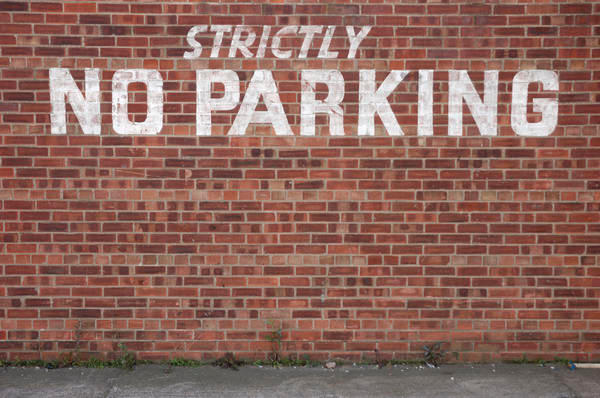The 8-mph speeding ticket and other automotive firsts
Did you know that France issued the world's first driver's licenses 15 years before the Henry Ford unveiled the Model T in 1908? Or that Britain adopted speed limits in the mid-1800s? Or that the earliest "No Parking" zone dates back to around 700 B.C.?
From license plates to car insurance, many of the laws and practices that drivers take for granted today came about at the automobile era's dawn in the late 1800s -- if not earlier.
"Laws about cars stem from the idea that the road itself should be regulated, and that's a concept that goes really far back in (Western) common law, probably back to the 15th or 16th century," says Catharine Wells, a Boston College Law School professor.
Experts don't necessarily agree on when some of today's automotive laws and practices initially appeared, but the dates that follow reflect the earliest instances documented by credible sources.
First 'No Parking' zone: c. 700 B.C.
The earliest known "No Parking" sign dates back to the reign of Assyrian King Sennacherib in 705-681 B.C., according to a 1954 book on traffic by New York Times transportation reporter Joseph C. Ingraham.
Ingraham wrote that a sign on the Assyrian capital of Nineveh's main thoroughfare read: "Royal Road -- Let No Man Decrease It." No one could park a chariot there under penalty of death.
(Source: Modern Traffic Control, by Joseph C. Ingraham)
First traffic signal: 1868
The first traffic signal arrived decades before gas-powered autos did, appearing near London's House of Parliament in 1868 to regulate pedestrians, horses and horse-drawn wagons. It consisted of red, yellow and green gas lights operated by a police officer, but only lasted a month before a leak caused one of the lamps to explode, seriously injuring or killing the operator -- accounts differ.
The first electric traffic light was invented in 1912 by a Utah policeman named Lester Wire. Installed in Salt Lake City in 1914, it had red and green lights that a police officer manually operated. Automated operation began in 1926.
The first red/yellow/green electric traffic signal appeared in Detroit in 1920, the brainchild of local policeman William Potts.
(Source: Famous First Facts, University of London Victoria County History project)
First speed limit: mid-1800s
The earliest speed limits harken back to at least the mid-19th century, often backed by railroads and carriage-makers that wanted to stifle development of steam vehicles (and later of gas-powered cars).
For example, Britain's 1861 Locomotive Act restricted early vehicles to just 10 miles per hour in rural areas and 5 mph in urban ones.
An 1865 revision was even stricter, setting speed limits at 4 mph in the country and 2 mph in cities and towns. Drivers also had to have someone to walk in front of their cars with a red flag. (U.K. car enthusiasts have celebrated that law's 1896 repeal with an annual London-to-Brighton road race ever since.)
America's earliest speed limit dates back to 1901, when Connecticut set a 12 mph maximum for the country and 8 mph for cities. Congress set America's famous 55 mph federal speed limit for all highways in 1974 to save gas amid the Arab oil embargo, but repealed the unpopular law 21 years later.
Today, 37 states have highway speed limits of 70 mph or higher.
(Source: British National Archives, British Royal Automobile Club, Book of Firsts)
First speeding ticket: 1896
Britain issued the earliest recorded speeding ticket in 1896, when authorities cited Walter Arnold of East Peckham, some 35 miles southeast of London.
Arnold was traveling through the town at 8 mph, or four times the 2 mph speed limit. A policeman on a bicycle caught up with the scofflaw, who ended up paying court costs and a 1-shilling fine (about eight U.S. cents at current exchange rates).
Today, U.S. motorists rack up about 112,000 speeding tickets a day, usually for going considerably faster than 8 mph. Not all insurance companies will raise rates for a single violation, but among those that do, the average increase after a speeding ticket is 11 percent.
(Source: British National Motor Museum)
The first license plate: 1889
France issued the world's first license plate to a Paris driver in 1889, with New York state requiring America's first such plates two years later.
Empire State drivers originally furnished their own license plates, writing their initials in 3-inch-high letters and providing the details to authorities. But Massachusetts unveiled America's first government-issued plates in 1903, giving a local driver a dark-blue one with the number "1" and "Mass. Automobile Register" written in white.
Connecticut offered the first vanity plates in 1937. Car owners with five years of good driving could pick three letters (usually their initials) to display on their plates.
(Source: Famous First Facts)
First car accident: 1891
The earliest recorded accident involving a gas-powered car occurred nearly two decades before the Model T.
Auto pioneer J.W. Lambert hit a tree root and careened into a hitching post in 1891 while driving a one-cylinder vehicle in Ohio City, now part of Cleveland. He and a friend sustained minor injuries.
Today, U.S. drivers are involved in about 6 million accidents a year. Even a small on your claims record can raise your rates; an Insurance.com survey of major carriers found an average increase of 18 percent.
(Source: Famous First Facts, Ohio History Central, Robertson's Book of Firsts)

 Yahoo Autos
Yahoo Autos 



